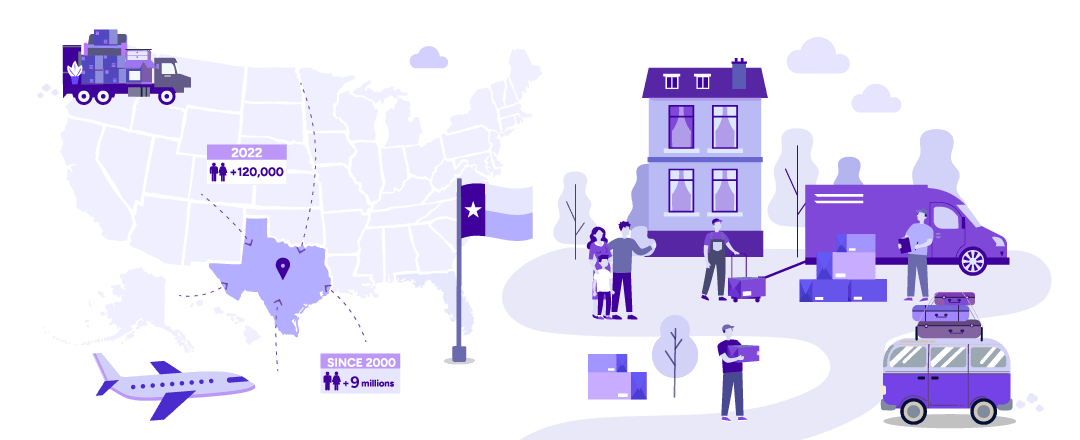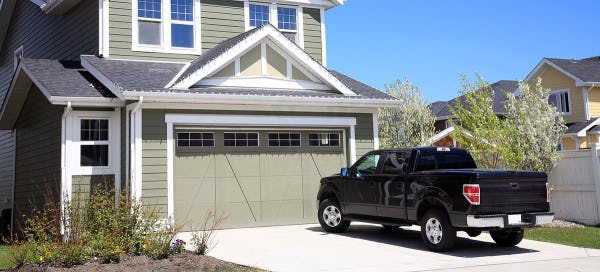Moving to Texas From Colorado: What You Need to Know
Moving from Colorado to Texas can feel like stepping into a whole new world. While the two states share a love of the outdoors and friendly communities, they differ in climate, cost of living, job markets, and overall lifestyle. In this guide, we’ll compare Colorado and Texas across multiple dimensions—like housing prices, taxes, weather, and more—so you can prepare for a smooth relocation and feel confident about your decision.
If you’re considering moving to Texas from Colorado, you’re in good company. Texas has become a magnet for newcomers, thanks to its robust job market, lower cost of living, and warm climate. But before you start packing, it’s wise to understand what life in the Lone Star State looks like compared to the Centennial State.
Colorado’s stunning mountains and four-season climate will give way to Texas’ more humid summers, mild winters, and flatter landscapes. Your new home might be near bustling cities like Houston, Dallas, or Austin, or perhaps in a smaller town with a slower pace of life. Taxes will shift, too—expect no state income tax in Texas, but be prepared for different property and sales tax structures. Even your approach to energy choices will change, as Texas offers a deregulated electricity market and more flexibility in choosing your provider.
Understanding the Differences Between Colorado and Texas
Climate & Geography
When moving to Texas from Colorado, be ready for a climate shake-up. Colorado’s average of 115-300 sunny days a year isn’t going away, but the weather you’ll experience is quite different. Instead of snowy winters and crisp mountain air, Texas offers long, hot summers and mild winters, with only occasional cold snaps. In Colorado, you might have enjoyed 60 inches of snow annually in some mountain towns. In Texas, prepare for heavier rainfall in certain regions, like Houston, and drier conditions in places like West Texas.
The mountainous terrain of Colorado will give way to a flatter landscape in most parts of Texas. But don’t fret—Texas boasts plenty of outdoor activities. Consider exploring Big Bend National Park, enjoying lakeside hikes near Dallas, or floating the rivers around the Hill Country. While you’ll leave behind the Rockies, you’ll gain a vast variety of activities thanks to Texas’ diverse landscapes.
Cost of Living & Housing
Cost of living is one of the biggest draws for Texans and newcomers alike. According to the U.S. Census and various economic reports, Colorado’s cost of living sits well above the national average. Housing in Denver, for instance, can easily exceed $600,000 for a single-family home.
In Texas, the median home price is closer to $300,000-$350,000, depending on the region (EIA and Census data & Census.gov). While property taxes can be higher in Texas, the absence of a state income tax often offsets these expenses. Groceries, healthcare, and transportation also tend to cost less in Texas, helping your budget stretch further.
Taxes & Regulations
In Colorado, you might be used to paying a flat state income tax, but in Texas, there’s no state income tax at all. This can mean more take-home pay—excellent news if you’re seeking financial perks. Be aware, though, that Texas has higher property taxes and slightly higher sales taxes, which can influence your monthly expenses. It’s a trade-off many residents find worthwhile, given the overall affordability of the state.
Job Market & Opportunities
Moving to Texas from Colorado doesn’t mean giving up good job prospects. Both states enjoy strong job markets. Colorado’s tech and aerospace industries have drawn many professionals, but Texas stands out with diverse sectors like energy, healthcare, tech, finance, and manufacturing.
Major cities—like Dallas-Fort Worth, Houston, and Austin—host Fortune 500 companies, startups, and everything in between. Salaries in Texas can be comparable or even higher than in Colorado, and combined with a lower cost of living, you might find your quality of life improving.
Getting Practical: Setting Up Your Life in Texas
Choosing the Right City or Region
Texas is huge—about 268,000 square miles—so take time to find a region that suits you. Prefer a high-octane city life? Consider Dallas or Houston. Crave a blend of tech opportunities and cultural quirks? Austin might be your jam. Seeking a quieter life? Smaller towns around San Antonio or East Texas offer charm and lower housing costs.
Understanding Electricity & Utilities
Colorado’s utilities are often regulated, meaning less complexity in choosing providers. In Texas, energy is deregulated in most areas. This gives you freedom to pick from many electricity providers, but requires more research. Look for a company with transparent pricing, renewable energy options, and reliable service.
Pro Tip: Check out Rhythm Energy’s Moving Hub for a handy checklist and steps to set up power at your new place quickly.
Another Pro Tip: For more tips on saving money during your move, read 11 Moving Tips and Tricks That Will Save You Time and Money.
Transportation & Commute
In Colorado, you might be used to relatively short commutes or even public transit options in Denver. In Texas, cities like Houston and Dallas can mean longer commutes due to urban sprawl and highway-centric infrastructure. Consider proximity to your workplace when choosing a neighborhood. Many Texans value having their own car due to the spread-out nature of most cities, though public transportation options are improving in some metropolitan areas.
Culture, Lifestyle & Community
Colorado is known for its laid-back, outdoor-centric culture. Texas also loves the outdoors, but the vibe is slightly different—think Friday night lights (high school football), barbecue cookouts, and a rich tapestry of cultures and cuisines. You’ll find people incredibly friendly and welcoming, making it easier to meet neighbors and get involved in community activities.
Sports fans can take comfort in knowing that Texas is a sports mecca—NBA, NFL, MLB, NHL, and major college sports abound. The pace of life can vary, but generally, Texans are proud of their state and eager to share local traditions with newcomers.
Colorado | Texas | |
Size (Land Area) | 104,094 sq miles | 268,596 sq miles |
Population (2023) | ~5.9 million | ~30 million |
State Capital | Denver | Austin |
Climate | Mountain climate with cold winters & mild summers | Hot summers, mild winters (varies by region) |
Economy | Tech, energy, tourism, agriculture | Energy (oil/gas), tech, agriculture, trade |
State Nickname | "The Centennial State" | "The Lone Star State" |
Highest Point | Mount Elbert (14,440 ft) | Guadalupe Peak (8,751 ft) |
Tips for a Smooth Move
Plan Early: Start preparing for your move at least a couple of months in advance. Book movers, declutter your home, and set a timeline.
Research Neighborhoods: Explore housing markets online, look at crime rates, school ratings, and property taxes to find a community that fits your lifestyle.
Compare Electricity Plans: With deregulated markets, it’s vital to understand how to pick the right energy provider. Consider reading about how to choose the best plan for your home and look for green options if sustainability matters to you.
Prepare for the Weather: Update your wardrobe, check your HVAC systems, and get ready for humid summers and mild winters. If you’re sensitive to heat, consider a home with ceiling fans or a smart thermostat for better climate control.
Embrace the Culture: The best way to adjust to your new home is by embracing local traditions. Try Texas barbecue, attend a football game, and join community events. The more you dive in, the quicker you’ll feel at home.
Relocating from Colorado to Texas can be a rewarding decision that enhances your quality of life. With a lower cost of living, robust job opportunities, diverse cultural experiences, and a warm climate, Texas often feels like a breath of fresh air. While you’ll swap the mountains for plains and the snowy winters for mild ones, you’ll still find abundant outdoor activities and friendly neighbors.
Adjusting to the differences in taxes, housing costs, and utility markets might feel daunting at first. But with careful planning—like researching neighborhoods, understanding the deregulated electricity market, and preparing for the weather—you’ll set yourself up for success. Embrace the Texan culture by exploring local foods, sports, festivals, and community traditions. These experiences will help you integrate quickly and feel at home.
In the end, moving to Texas from Colorado might just be one of the best decisions you’ve made—offering a chance to write a new chapter in a place full of growth, opportunity, and warm-hearted community spirit.

FAQ
Do I need a new driver’s license immediately after moving?
You typically have 30 days after establishing residency to obtain a Texas driver’s license. Visit the Texas Department of Public Safety (DPS) office with required documents.
Will I pay more or less in taxes after moving to Texas?
You’ll pay no state income tax in Texas, which can save you money. However, property taxes are often higher, and sales taxes are slightly higher as well.
Can I still enjoy outdoor activities in Texas?
Absolutely. While you’ll trade alpine hikes for river tubing or coastal visits, Texas offers diverse outdoor experiences year-round.
How does Texas handle renewable energy if I want to go green?
Texas is a leader in wind and solar energy. You can sign up for green energy plans and even consider installing solar panels on your new home.
How do I pick an electricity plan in a deregulated market?
Compare rates, look for transparent companies, consider renewable options, and ask about fixed or time-of-use plans.




